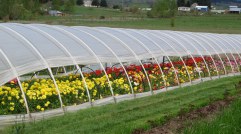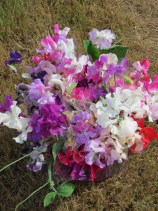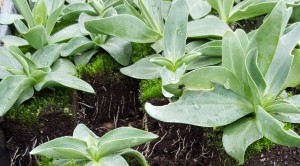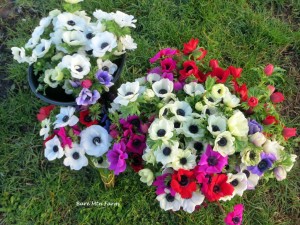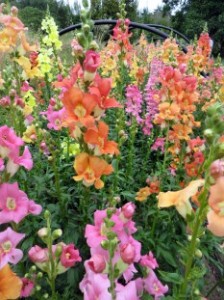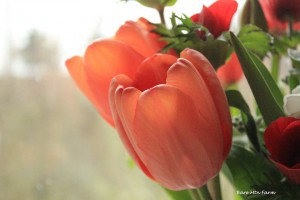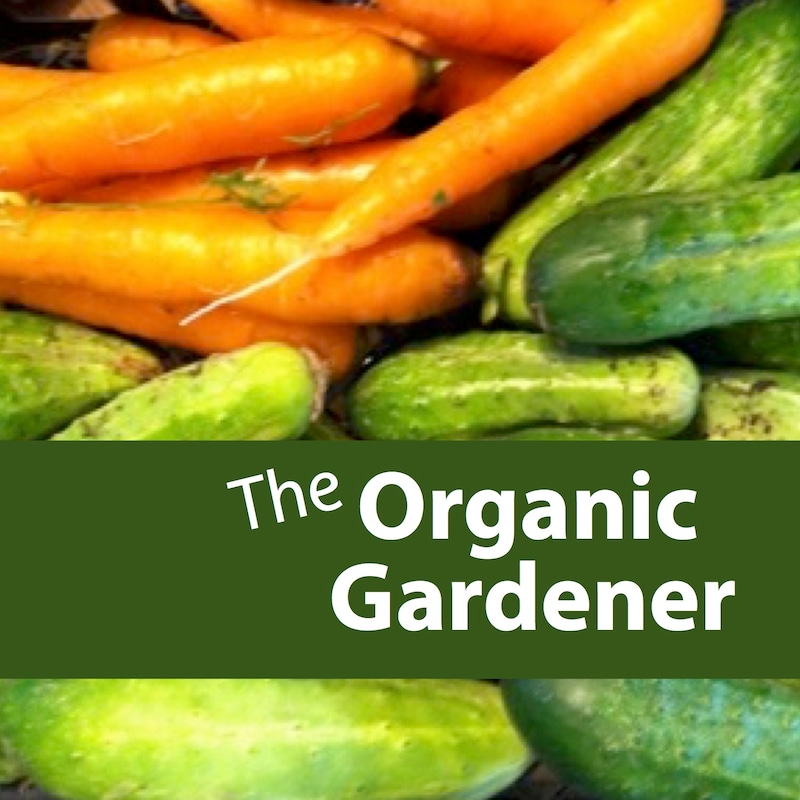
Shownotes
Originally published Jan 1, 2016
Denise and Tony Gaetz, from Bare Mountain Farm are here to share their flower farming journey. Their belief is that healthy soils equal healthy plants which provide for vibrant, strong long-lasting blooms.
Tell us a little about yourself.
Denise: We live in the Willamette Valley of Oregon, we’ve been on our farm for about 27 years, we have 10 and 1/2 acres. We grow flowers on only about an acre and 1/2. We’ve been doing this for over 11 years, starting next year will be our 12th season. This is our second career. We both had a previous life and are sort of semi-retired, but not really retired because this is a lot of work. But we’re doing something that both of us really love, it’s hard work but it’s super we enjoy it!
We have 4 unheated, unlit hoop houses that we have built, we have a little greenhouse where we start everything. For the first ten years of our business we sold in the Farmer’s Market in Corvallis, Oregon. A couple of years ago, the demand for our flowers from florists and designers increased, so we started to sell directly to florists and designers. The Farmer’s Market was a blast and we really loved it but it was a lot of work and very long days! So we decided we would let that one go, and just sort of focus on selling directly to florist shops and designers all up and down the valley. From Portland all the way to Eugene.
Tony: We are what you might call a micro-farm in a sense that our objective is not to become world flowers inc but to use sustainable practices develop a nice business that really concentrates on selling to a local area. We sell from Eugene which is the southern end of the valley to Protalnd on the northern end. A lot of what we sell is seasonal. We do some season extension as Denise allege about in our hoop houses.
What we try to do get our product at is at peak for our area and work it that way instead of we were trying to raise orchids in the middle of winter or something like that well sweet peas are on in June. It’s that sort of thing. We try to keep an emphasis on keeping it seasonal!
Tell me about your first gardening experience?
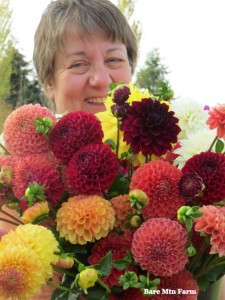 Denise: I’ve been growing flowers and veggies since I was a little kid. I think my first experience with flowers is about 7 years old growing pansies in Montana! When my family moved to Oregon later on, it was my responsibility in the family to grow as many vegetables and learn to preserve and can them and freeze them and what not for the family. I always had sort of an interest in plants. I spent a lot of time in high school and early college in horticulture programs, I also worked several years for a florist. I’ve always been really interested in growing things particularly food but my passion was pretty flowers.
Denise: I’ve been growing flowers and veggies since I was a little kid. I think my first experience with flowers is about 7 years old growing pansies in Montana! When my family moved to Oregon later on, it was my responsibility in the family to grow as many vegetables and learn to preserve and can them and freeze them and what not for the family. I always had sort of an interest in plants. I spent a lot of time in high school and early college in horticulture programs, I also worked several years for a florist. I’ve always been really interested in growing things particularly food but my passion was pretty flowers.
Tony: My respect I started when I was a kid too. The family always had a garden, when I 12 years old it became my assigned chore. And when you’re 12, your like oh great you know. But I really started getting into it, and learned a lot, I just started reading a lot. For a 12 years old that’s really weird. I read a lot of organic gardening magazines. This is the 1970’s. 1972, that range of time, we I learned a lot just by reading and what my family had done at that point. Our family kind of followed organic practices and we had our own place, and it was the natural thing to start that whole process again.
Where were you raised Tony? Are you also from Montana?
My father was in the army and worked for the army for most of his career, so we moved around a lot. Not necessarily on military basis. We lived back East in Virginia, and lived in California and Washington, just kind of as his career went, we went. That was also part of the challenge, new places presented a whole new set of new challenges.
Denise: We met here at Oregon State University, we both attended the University and that’s where we met and after we graduated then we got married. And we’ve been growing gardens and flowers ever since.
What does organic gardening/earth friendly mean to you?
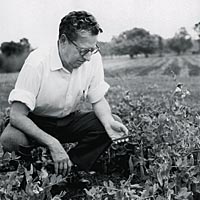 Well that’s kind of our philosophy, a lot of these philosophical things kind of evolved over a period of time. Sources of inspiration for us have been, besides J.I. Rodale. There’s also Fukuoka and Natural Farming, learning a lot more about permaculture and that movement. What we try to practice here philosophically, is we’re not certified organic, in many respects we’re beyond organic. I don’t mean that in a haughty way.
Well that’s kind of our philosophy, a lot of these philosophical things kind of evolved over a period of time. Sources of inspiration for us have been, besides J.I. Rodale. There’s also Fukuoka and Natural Farming, learning a lot more about permaculture and that movement. What we try to practice here philosophically, is we’re not certified organic, in many respects we’re beyond organic. I don’t mean that in a haughty way.
A lot of organic farmers now-a-days use organically approved things that could be called pesticides, herbicides, fertilizers, we tend to not use anything other then replacement of the minerals in the soil itself. We use natural fertilization in terms of compost that is either made here on site, or we use some recycled compost that’s made by a company here locally. What we try to do is keep the soil fertility up, that’s really our key focus, start with the soil build from there.
Our philosophy has been a healthy plant grown in healthy soil doesn’t need additional fertilizers pesticides or things of that nature as best as we can. Also as we go through look at what we grow, we make decisions about things that don’t grow well in our location or particular climate, we try to look at the plants that thrive the best here.
Who or what inspired you to start using organic techniques?
Denise: We were also inspired by a lot of our local growers, since we spent so much time at the farmer’s market there are a whole lot of growers that sell at the market that are fantastic people to follow and understand and kind of emulate their practices. We got a lot of that from a couple of really terrific growers in Denison’s Family Farm and Gathering Together Farm. Both of those are doing fantastic things with season extension and organic practices and sustainability and they were very kind to us and helping us find our way along the way. We’re always inspired by what other small time, small people, local growers are doing. And also paying forward what we learned.
Tony: Philosophically part of what we look at, there are some circles that say if you learn this info you should charge money, but what we try to do is help the new growers avoid some of the dumb things we did. So it’s kind of like Denise is saying paying it forward more of an obligation, that we look at it from a more philosophical standpoint that knowledge to help people, either local people or local flowers or local agriculture, things that can thrive on a micro easies is different then a mega farm that have five thousand acres and has millions of dollars of equipment. We don’t operate that way on any level, a lot of what we do is somewhat under the radar. A lot of companies are starting to pick up on the fact that small farms need unique tools and things of that nature.
I want to say I found you guys because you posted on Facebook and you had Dahlias and people were signing up like crazy?
That was the Lisianthus we were posting about. Lisianthus is a tricky flower. It is an absolutely beautiful flower that kind of looks like a rose. But its a tricky flower to get started form seed, it takes an incredible long long time to get it started and sometimes it doesn’t even germinate. So we’ve been playing around figuring out how to get it to germinate and how to get it up to size and into the ground. And low and behold we were experimenting, which is what we do an awful lot, we try things just to see if that will work. We decided we would try the Lisianthus for a cooler period of planting, because we had such a hard time last summer was way too hot for them.
We got them to germinate in soil blocks that we have been working with, and they grew up nicely and we put them in the ground. It was a total experiment of can we make them grow through the winter? They are fairly cool seasonsish, although they do well in the summer. We wanted to see if we could make them grow and bloom early in the spring next year and that was our experiment. So I posted it to the flower farmers, and say hey take a look at our experiment, and maybe it will work and maybe it won’t.
Our comment was “if it does you’ll hear about it and if it doesn’t it never happened!”
Tell us about a flower that grew well this year.
Anemones
What grew well this year was the anemones. There are a few other things, but I will just start with the anemones, becasue they are one of my favorite flowers. The reason I love anemones is because they are just the toughest little plant and flower that you can imagine. They can grow through sometimes some of the roughest weather we can have. We do grow them in a an unheated hoop house or what we call a crate house, because we are growing them currently in crates in a little house. Mostly to keep the cold Oregon rain off of them, it’s not so much that we are protecting them from frost, although we do provide some frost protection. We’ve had them make it though on some pretty cold winters. They are one of the first flowers to bloom for us!
The goal is always to try to get them on Valentines Day. Because our florists and designers absolutely love them! They are so bright and cherry, and such a pretty flower for Valentines Day! Something different then the traditional rose or carnation and what not. This year we were able to harvest our first anemones on the fifteenth of January. We were so excited that we had them on time for Valentines.
Scented Geraniums
The other thing that grew well for us this year was Scented Geraniums! We had a nice hundred foot row of scented geraniums, because we had such a mild winter last year we were able to keep protected and then when the weather warmed up they just started to go crazy. We were able to harvest them, probably from Early May until our first really hard frost at the end of November…
It was the week before Thanksgiving.
Snap dragons
That’s a pretty common flower, there are some new varieties that are what they call open faced butterfly. They don’t have the traditional snap look, they have an open petal look to them. The florist have been really receptive to those! We grew a lot of those.
Sweet peas are always a big thing. They just remind folks of s simpler times or maybe something their grandmother did or something of that nature.
Tulips
There’s also on the early part of the spring: tulips. Quite a few of the taller varieties. The shorter ones get shipped on the more wholesale, so we usually look for a more unusual color, or a taller stem or something that sets them apart or being different. Different petals or parrots or doubles.
So our season goes from, like last year it went from Jan 15th to Thanksgiving. That’s a little longer then normal, in a normal year from about first of February to the first of November. It just seems like the climate this last year was exceptionally warm. So it enabled things to move along faster then normal.
When the day length gets shorter and shorter, as hard as we want to keep the flowers growing, they just stop producing nice big blooms. They may not die but they don’t produce. We just haven’t gone to any kind of lighting and any of that kind of stuff. There’s typically, kind of a dead zone where plants don’t grow that much even when the temperatures are that moderate. That usually runs when you have daylight that hits 9 hours on the other side coming out, things start growing again.
Some times you’re kind of nervous at this time this year, you think I got my ranunculus in but they don’t seem that big, at Christmastime they should be bigger then that so they hit! But as soon as they hit that 9 hour mark., it’s incredible how much they can change in a short period of time.
That they are really doing there, the roots are all growing and getting bigger and stuff, so that when they do hit that time, they have a super great root system, then that’s a stronger plant that has more blooms and they get even bigger. Then they have really big fluffy blooms.
Have you guys heard of Lisa Ziegler from Cool Flowers? She’s been my guest twice she talks about the same thing, but she’s on the other coast, in Virginia. I was going to remind people to get her book for Christmas. She has documented and is an amazing wealth of information.
We have her book. We’ve read it from cover to cover!
Did you get your soil blocks from her? That’s what reminded me because that’s the first place I heard of it, and I think I didn’t understand till I saw the pictures in her catalog actually.
Soil Blocks
We’ve been doing it for years and years, we’ve bene in a tranisition away from plastic plugs. What started it with us, is we just got tired of plastic. The transitione noticed the quality of the plug. The plug trays work well in a large industrial, with automate machines where they fill them and plant them with a nice chemical soup of fertilizer. What we noticed for us as a small grower, that the quality of the plant the roots tended to get, no matter what you tried, the roots would swirl around the edge of the plastic, and the plant was not developing as good of a root system.
Without a soil block system the plants didn’t develop as good of a root system. With a soil block system what we noticed is that the plants develop a more even root growth, and the fact that the edge of the block has a minute amount of air around it will actually root prune the plants. So the roots will stop growing, so they don’t wrap around themselves, so the plants end up with a better root system.
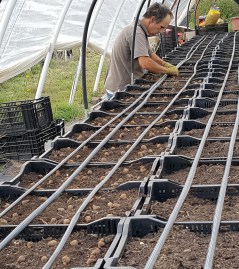
That’s what drove us to do it, it was producing a much better plant. They were stronger seedlings to put in, it was also serendipity for us, as it bought us a little more time! There’s just the two of us and a million jobs to do on the farm. Even though we want to get that seedling into the ground on the specific day, sometimes, its a week or you have a break down on it, or you need to do more soil prep, the plant continues to grow and thrive in that soil block. It’s like we missed that deadline by ten days, oh well the plant still looks
